AUDI S3 2009 Owners Manual
Manufacturer: AUDI, Model Year: 2009, Model line: S3, Model: AUDI S3 2009Pages: 324, PDF Size: 76.02 MB
Page 251 of 324
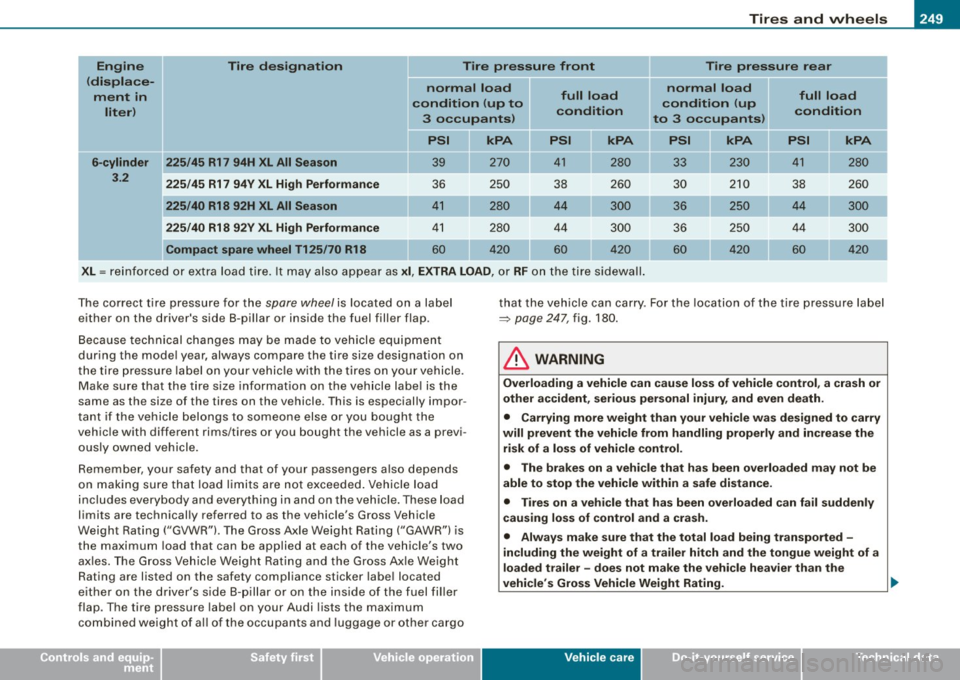
________________________________________________ T_ i _r_e _s_ a_n_ d_ w_ h_ e_e _ l_s __ lJlll
•
Engin e Tire designation Tire pressure front Tire pressure rear
(displace- normal load normal load
ment in full load
full load
liter ) c
ondit ion (up to
condition c
ondition (up
condition
3 occupants ) to 3 occupants)
PSI PSI kPA PSI kPA kPA
6-cylinder 225/45 R1 7 94H XL All Season 39 41 280 230 41 280
3 .2
225 /45 R17 94V XL High Performance
36 250 38 260 30 2
10
38 260
225 /40 R18 92H XL All Season
4 1 280 44 300 36 250 44 300
225 /40 R18 92V XL High Performance 41 280 44 3 0 0 36 250 44 30 0
Compact spare wheel T125 /70 R18
60 420
60 420
60 4
20
60 420
XL=
reinforced o r extra load tire . It may also appear a s xi , EXTRA LOAD, or RF on t he ti re s id ewa ll.
The correct tire pressure fo r t he spare wheel is located on a label
either on the driver's side B-pi llar or inside th e fuel filler flap .
Beca use technical change s may be ma de to vehicle equip ment
during the mode l year, always compare the tire size designat ion on
the tire p ressure label on your vehic le with the ti res on you r vehicle.
Make sure that the tire size informat ion on the veh icle labe l is the
same as the size of the tires on the vehicle . T his is especially impor
t ant if the veh icle belongs to someone else or you bough t the
vehic le with different rims/tires or you bought the vehicle as a previ
ousl y owne d ve hicle.
Remember , your safety and that of your passengers a lso depends
o n mak ing s ure tha t loa d limits are not exceeded . Vehicle load
includes everybody and everything in and on the vehic le. These load
limits are technical ly referred to as the vehicle's Gross Vehicle
Weight Rating ( "GVWR"). The Gross Axle Weight Rating ("GAWR") is
the maximum load that can be applied at each of the vehicle's two
a xl es . T he Gross Vehic le W eight Rat ing and the Gross A xle Weight
Rating are listed on the safety compliance sticker labe l located
ei the r on the driver's s ide B -pi ll ar or on the i nside of the fuel fill er
flap . T he tire pressure labe l on your Audi lists the maximum
co mbined weig ht o f all of the occupants a nd luggage or oth er ca rgo that t
he ve hicle can carry . For the locatio n of the ti re p ressure la bel
=> page 247, fig. 180.
& WARNING
Overloading a vehicle can cause loss of vehicle control , a crash or
other accident , serious personal injury, and even death .
• Carrying more weight than your vehicle wa s designed to carry
will prevent the vehicle from handl ing properly and increase the
ri sk of a loss of vehicle control .
• The brakes on a vehicle that has been overloaded may not be
able to stop the vehicle within a safe distance .
• Tires on a vehi cle that has been overloaded can fail suddenly
cau sing loss of control and a crash.
• Always make sure that the total load being transported -
including the weight of a trailer hitch and the tongue weight of a
loaded trailer -does not make the vehi cle heavier than the
vehicle 's Gross Vehicle Weight Rating. _,.
Vehicle care
I t •
Page 252 of 324
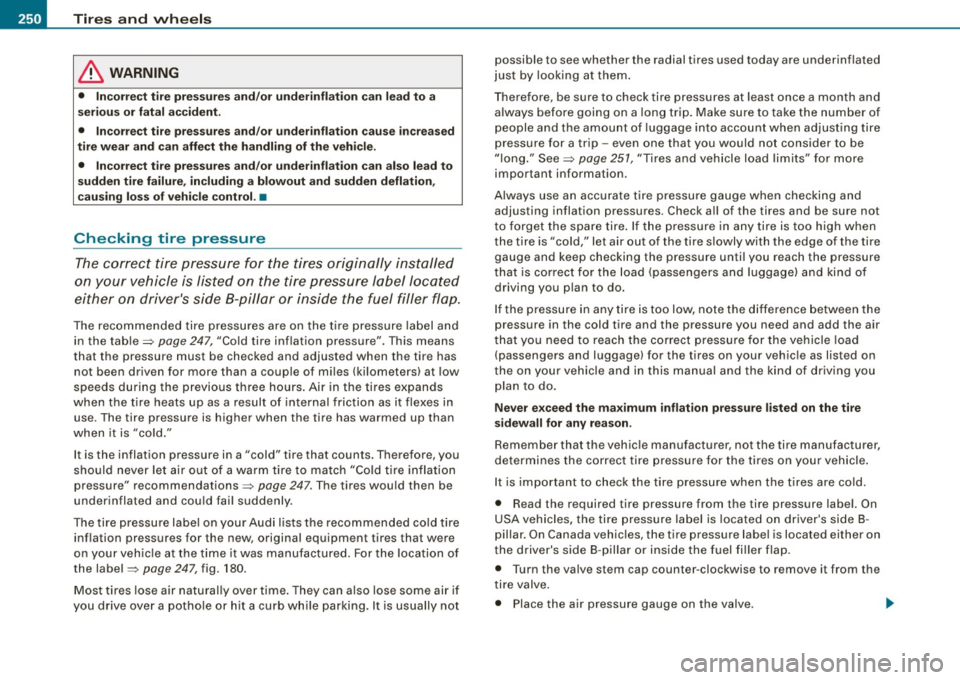
.,,.___T_ ir_e_ s _ a_ n_d_ w_ h_ e_e _ l_s _________________________________________________ _
& WARNING
• Incorrect tire pressures and/or underinflation can lead to a
serious or fatal accident.
• Incorrect tire pressures and/or underinflation cause increased
tire wear and can affect the handling of the vehicle.
• Incorrect tire pressures and/or underinflation can also lead to
sudden tire failure, including a blowout and sudden deflation,
causing loss of vehicle control. •
Checking tire pressure
The correct tire pressure for the tires originally installed
on your vehicle is listed on the tire pressure label located
either on driver's side 8-pillar or inside the fuel filler flap.
The recommended tire pressures are on the tire pressure label and
in the table=> page 247, "Cold tire inflation pressure". This means
that the pressure must be checked and adjusted when the tire has
not been driven for more than a couple of miles (kilometers) at low
speeds during the previous three hours. Air in the tires expands
when the tire heats up as a result of internal friction as it flexes in
use. The tire pressure is higher when the tire has warmed up than
when it is "cold."
It is the inflation pressure in a "cold" tire that counts. Therefore, you
should never let air out of a warm tire to match "Cold tire inflation
pressure" recommendations=>
page 247. The tires would then be
underinflated and could fail suddenly.
The tire pressure label on your Audi lists the recommended cold tire inflation pressures for the new, original equipment tires that were
on your vehicle at the time it was manufactured. For the location of
the label=>
page 247, fig. 180.
Most tires lose air naturally over time. They can also lose some air if
you drive over a pothole or hit a curb while parking. It is usually not possible to see whether the radial tires used today are underinflated
just by looking at them.
Therefore , be sure to check tire pressures at least once a month and
always before going on a long trip. Make sure to take the number of
people and the amount of luggage into account when adjusting tire
pressure for a trip -even one that you would not consider to be
"long." See=>
page 251, "Tires and vehicle load limits" for more
important information .
Always use an accurate tire pressure gauge when checking and
adjusting inflation pressures . Check all of the tires and be sure not
to forget the spare tire. If the pressur e in any tire is too high when
the tire is "cold," let air out of the tire slowly with the edge of the tire
gauge and keep checking the pressure until you reach the pressure
that is correct for the load (passengers and luggage) and kind of
driving you plan to do.
If the pressure in any tire is too low, note the difference between the
pressure in the cold tire and the pressure you need and add the air
that you need to reach the correct pressure for the vehicle load
(passengers and luggage) for the tires on your vehicle as listed on
the on your vehicle and in this manual and the kind of driving you
plan to do.
Never exceed the maximum inflation pressure listed on the tire
sidewall for any reason.
Remember that the vehicle manufacturer, not the tire manufacturer,
determines the correct tire pressure for the tires on your vehicle.
It is important to check the tire pressure when the tires are cold.
• Read the required tire pressure from the tire pressure label. On
USA vehicles, the tire pressure label is located on driver's side B
pillar. On Canada vehicles, the tire pressure label is located either on
the driver's side B-pillar or inside the fuel filler flap.
• Turn the valve stem cap counter-clockwise to remove it from the
tire valve.
• Plac e the air pressure gauge on the valve. .,_
Page 253 of 324
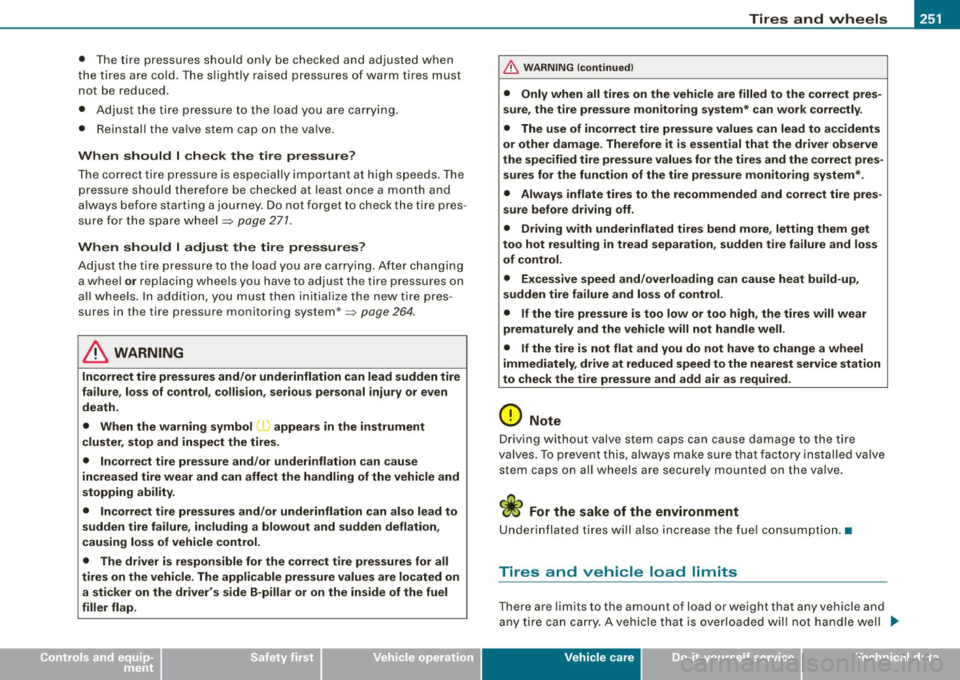
Tires and wheels -
----------------
•
• The tire pressures should only b e chec ked and ad just ed wh en
t he tire s are co ld. The s lig ht ly rai se d pre ss u res of w arm tires mu st
not b e reduced .
• Adjust t he tire pressure to the lo ad you ar e carrying.
• Reinstal l the va lve stem cap on the va lve .
When should I check the tire pressure?
The correc t ti re p ress ure is es pec ially im portant a t high speeds. The
press ure s hou ld t here fore be checked at least once a mo nth and
a lways before starting a journey. Do not forget to check the tire pres
su re for t he spare whee l=>
page 2 71.
When should I adjust the tire pressures?
Ad just the tire pressure to the load you are carryin g. After c han ging
a whee l
or replacing whee ls you have to adj ust th e tire pre ssu re s on
a ll w he el s. In add itio n, you must the n initialize the new t ire pres
su res in the tire pressure monitoring system*=>
page 264.
& WARNING
Incorrect tire pressures and /or underinflation can lead sudden tire
failure , loss of control, collision, serious personal injury or even
death .
• When the warning symbol
l.J appears in the instrument
cluster , stop and inspect the tires .
• Incorrect tire pressure and /or underinflation can cause
increased tire wear and can affect the handling of the vehicle and
stopping ability .
• Incorrect tire pressures and/or underinflation can also lead to
sudden tire failure , including a blowout and sudden deflation ,
causing loss of vehicle control .
• The driver is responsible for the correct tire pressures for all
tires on the vehicle. The applicable pressure values are located on a st icker on the dr iver 's side B -pillar or on the inside of the fuel
filler flap.
& WARNING (continued )
• Only when all tires on the vehicle are filled to the correct pres
sure, the tire pressure monitoring system * can work correctly.
• The use of incorrect tire pressure values can lead to accidents
or other damage . Therefore it is essential that the driver observe
the specified tire pressure values for the tires and the correct pres
sures for the function of the tire pressure monitoring system *.
• Always inflate tires to the recommended and correct tire pres
sure before driving off.
• Driving with underinflated tires bend more , letting them get
too hot resulting in tread separation , sudden tire failure and loss
of control.
• Excessive speed and /overloading can cause heat build -up ,
sudden tire failure and loss of control.
• If the tire pressure is too low or too high , the tires will wear
prematurely and the vehicle will not handle well .
• If the tire is not flat and you do not have to change a wheel
immediately, drive at reduced speed to the nearest service station
to check the tire pressure and add air as required .
0 Note
Driving without valve stem caps can cause damage to the tire
va lv es. To p revent this, a lways mak e su re that fac to ry insta lled va lve
stem caps on al l wheels a re sec urely mounted on the va lve .
Tires and vehicle load limits
There are limits to the amount of load or weight that any vehicle and
any tire can ca rry. A ve hicle tha t is ove rlo ade d wi ll not h and le w ell ..,
Vehicle care I t •
Page 254 of 324
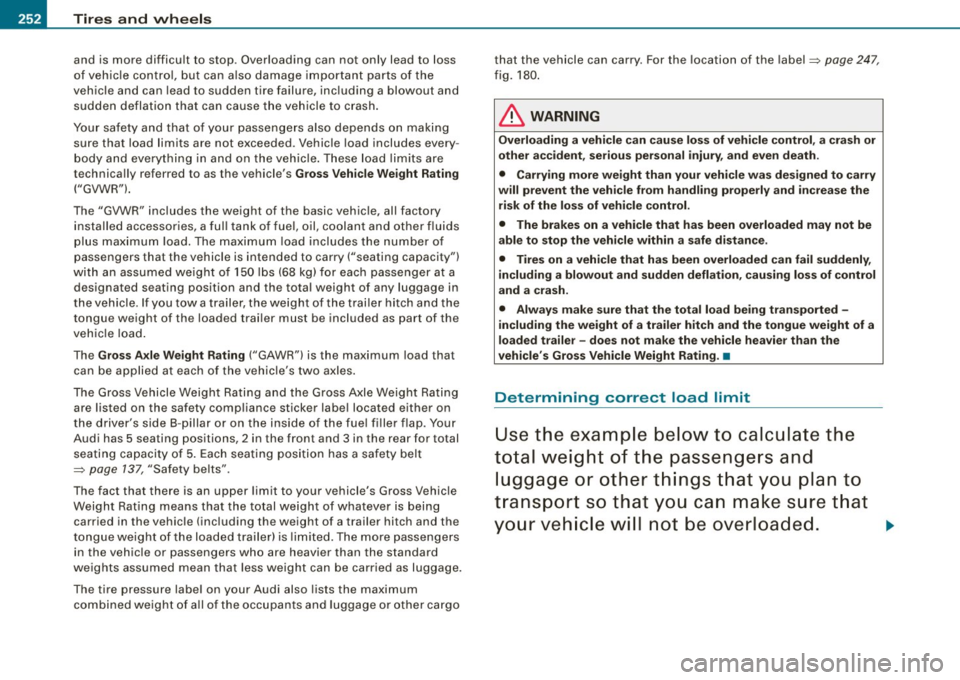
-Tires and wheels
P'tr:1-------------------
and is more difficult to stop. Overloading can not only lead to loss
of vehicle control, but can also damage important parts of the
vehicle and can lead to sudden tire failure, including a blowout and
sudden deflation that can cause the vehicle to crash.
Your safety and that of your passengers also depends on making
sure that load limits are not exceeded. Vehicle load includes every
body and everything in and on the vehicle. These load limits are
technically referred to as the vehicle's
Gross Vehicle Weight Rating
("GVWR").
The "GVWR" includes the weight of the basic vehicle, all factory
installed accessories, a full tank of fuel, oil, coolant and other fluids
plus maximum load. The maximum load includes the number of
passengers that the vehicle is intended to carry ("seating capacity")
with an assumed weight of 150 lbs (68 kg) for each passenger at a
designated seating position and the total weight of any luggage in
the vehicle. If you tow a trailer, the weight of the trailer hitch and the
tongue weight of the loaded trailer must be included as part of the
vehicle load.
The
Gross Axle Weight Rating ("GAWR") is the maximum load that
can be applied at each of the vehicle's two axles.
The Gross Vehicle Weight Rating and the Gross Axle Weight Rating
are listed on the safety compliance sticker label located either on
the driver's side B-pillar or on the inside of the fuel filler flap. Your
Audi has 5 seating positions, 2 in the front and 3 in the rear for total
seating capacity of 5. Each seating position has a safety belt
=>
page 137, "Safety belts".
The fact that there is an upper limit to your vehicle's Gross Vehicle
Weight Rating means that the total weight of whatever is being
carried in the vehicle (including the weight of a trailer hitch and the
tongue weight of the loaded trailer) is limited. The more passengers
in the vehicle or passengers who are heavier than the standard
weights assumed mean that less weight can be carried as luggage.
The tire pressure label on your Audi also lists the maximum
combined weight of all of the occupants and luggage or other cargo that the vehicle can carry.
For the location of the label=>
page 247,
fig. 180.
& WARNING
Overloading a vehicle can cause loss of vehicle control, a crash or
other accident, serious personal injury, and even death.
• Carrying more weight than your vehicle was designed to carry
will prevent the vehicle from handling properly and increase the
risk of the loss of vehicle control.
• The brakes on a vehicle that has been overloaded may not be
able to stop the vehicle within a safe distance.
• Tires on a vehicle that has been overloaded can fail suddenly,
including a blowout and sudden deflation, causing loss of control
and a crash.
• Always make sure that the total load being transported -
including the weight of a trailer hitch and the tongue weight of a
loaded trailer -does not make the vehicle heavier than the
vehicle's Gross Vehicle Weight Rating. •
Determining correct load limit
Use the example below to calculate the
total weight of the passengers and luggage or other things that you plan to
transport so that you can make sure that
your vehicle will not be overloaded.
~
Page 255 of 324
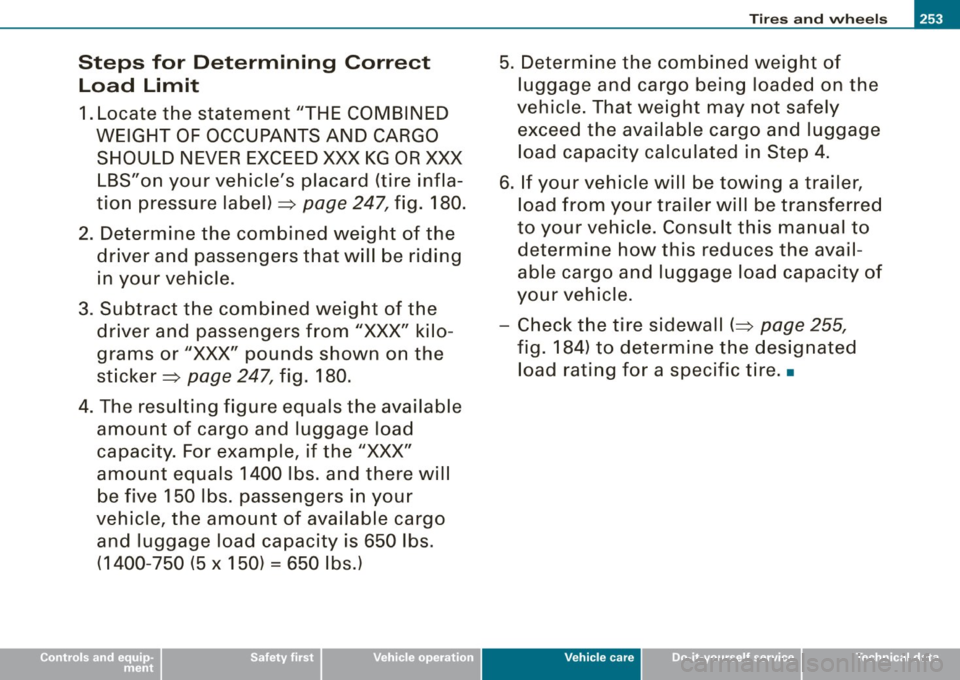
Steps for Determining Correct Load Limit
1. Locate the statement "THE COMBINED
WEIGHT OF OCCUPANTS AND CARGO SHOULD NEVER EXCEED XXX KG OR XXX
LBS"on your vehicle's placard (tire infla
tion pressure label)=>
page 247, fig. 180.
2. Determine the combined weight of the
driver and passengers that will be riding
in your vehicle.
3. Subtract the combined weight of the
driver and passengers from
"XXX" kilo
grams or
"XXX" pounds shown on the
sticker=>
page 247, fig. 180.
4. The resulting figure equals the available
amount of cargo and luggage load capacity. For example, if the
"XXX"
amount equals 1400 lbs. and there will
be five
150 lbs. passengers in your
vehicle, the amount of available cargo
and luggage load capacity is
650 lbs.
( 1400- 750 (5 x 150) = 650 I bs.)
Tires and wheels 111111
5. Determine the combined weight of luggage and cargo being loaded on the
vehicle. That weight may not safely exceed the available cargo and luggage
load capacity calculated in Step
4.
6.
If your vehicle will be towing a trailer,
load from your trailer will be transferred
to your vehicle. Consult this manual to
determine how this reduces the avail
able cargo and luggage load capacity of
your vehicle.
- Check the tire sidewall (=>
page 255,
fig. 184) to determine the designated
load rating for a specific tire. •
Vehicle care I • •
Page 256 of 324
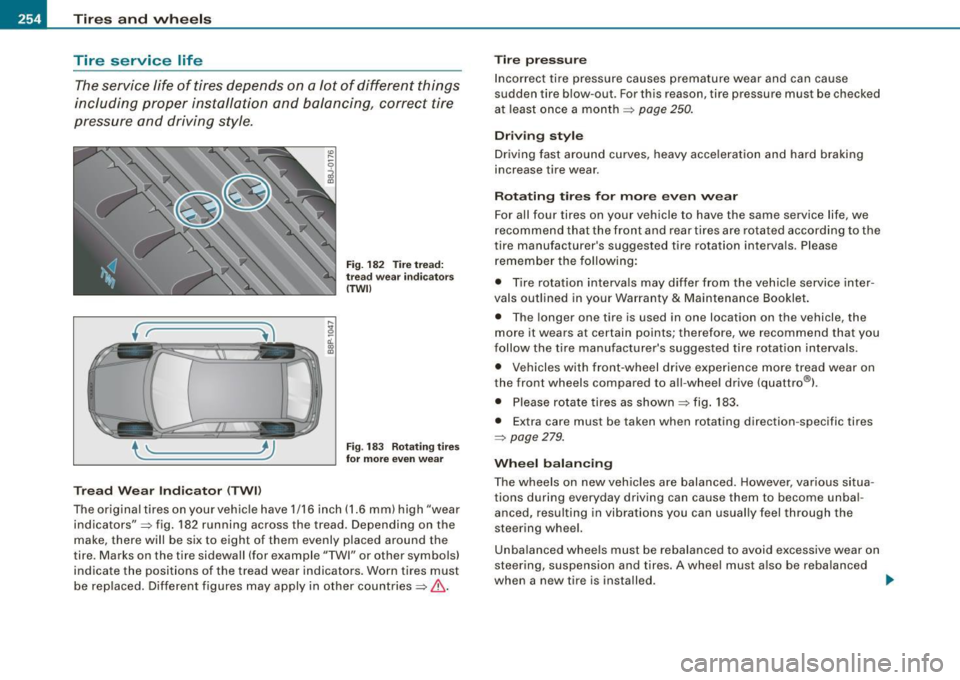
___ T_ i_ r_e _s_ a_ n_ d_ w_ h_ e_ e _ ls _________________________________________________ _
Tire service life
The service life of tires depends on a Jot of different things
including proper installation and balancing, correct tire
pressure and driving style .
(r
l \._ _____ ;)
Tread Wear I nd ica tor ( TWll
Fig. 182 Tire tread:
tr ea d wea r ind ica tors
( TWIJ
Fi g. 1 83 Ro tati ng tir es
for mor e even wea r
The or iginal tires on your vehicle have 1/16 inch (1.6 mm) high "wear
indicators":::::, fig. 182 running across the tread . Depending on the
make, there will be six to eight of them evenly placed around the
tire . Marks on the tire sidewall (for example "TWI" or other symbols)
indicate the positions of the tread wear indicators . Worn tires must
be replaced. Dif ferent figures may apply in other countries:::::,&.
Tir e p re ss ure
Incorrect tire pressure causes premature wear and can cause
sudden tire blow-out . For this reason, tire pressure must be checked
at least once a month :::::,
page 250.
Drivin g sty le
Driving fast around curves, heavy acce leration and hard braking
increase tire wear .
Rotating tires for more even wear
For all four tires on your vehicle to have the same service life, we
recommend that the front and rear tires are rotated according to the
tire manufacturer's suggested tire rotation intervals . Please
r emember the following:
• Tire rotation interva ls may differ from the vehic le service inter
vals outlined in your Warranty
& Maintenance Booklet.
• The longer one tire is used in one location on the vehicle, the
more it wears at certain points; therefore, we recommend that you
follow the tire manufacturer's suggested tire rotation intervals.
• Vehicles with front -wheel drive experience mo re tread wear on
the front wheels compared to all-wheel drive (quattro®) .
• Please rotate tires as shown :::::, fig . 183.
• Extra care must be taken when rotating direction -specific tires
:::::, page 279.
Whe el b ala n cing
The wheels on new vehicles are balanced. However, various situa
tions during everyday driving can cause them to become unba l
anced, resulting in vibrations you can usual ly feel through the
steering wheel.
Unba lanced whee ls must be rebalanced to avoid excessive wear on
steering, suspension and tires. A wheel must a lso be reba lanced
when a new tire is installed.
~
Page 257 of 324
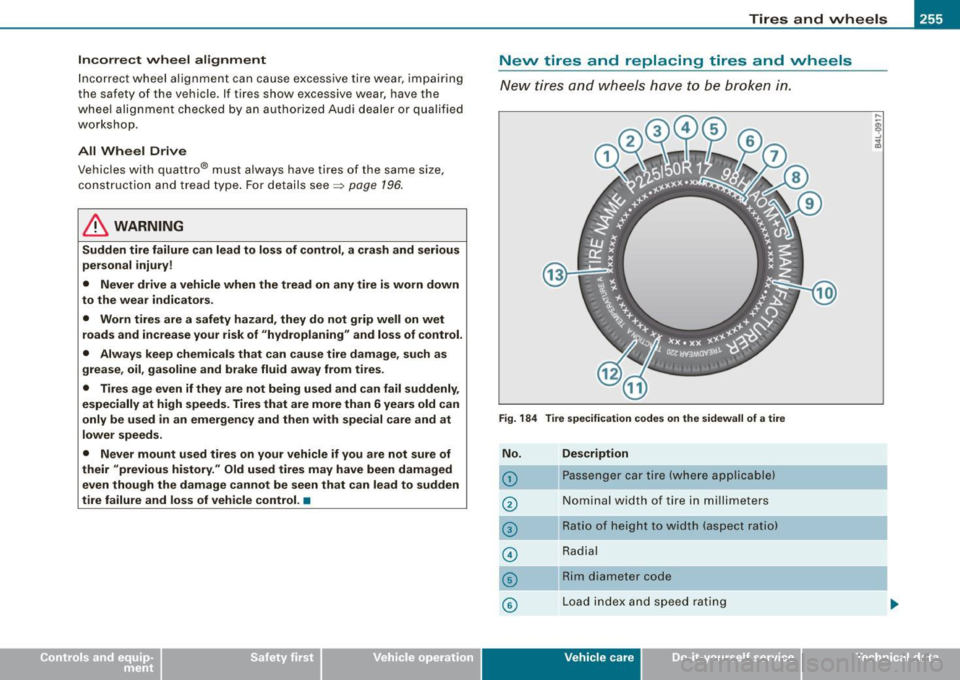
Tires and wheels -_______________ _____.
Incorrect wheel alignm ent
Inc orrect wheel alignment ca n cause excessive tire wear, impairing
the safety of the vehicle . If tires show excessive wear, have the
whee l alignment chec ked by an autho rized A udi deale r or qu alifie d
wor kshop .
All Wheel Drive
Vehicles with quattro® must always have tires of the same size,
co nst ructi on an d tread type . For detail s see =>
page 196 .
& WARNING
Sudden tire failure can lead to lo ss of control, a crash and serious
personal injury!
• Never drive a vehicle when the tread on any tire is worn down
to the wear indi cators.
• Worn tire s are a safety hazard , they do not grip well on wet
roads and increase your risk of "hydroplaning " and loss of control.
• Always keep chemicals that can cau se tire damage , such a s
grease , oil , gasoline and brake fluid away from tires.
• Tires age even if they are not being used and can fail suddenly ,
especially at high speeds . Tire s that are more than 6 years old can
only be used in an emergency and then with special care and at
lower speeds .
• Never mount used tire s on your vehicle if you are not sure of
their "previou s hi story. " Old used tires may have been damaged
even though the damage cannot be seen that can lead to sudden
tire failu re and loss of vehi cle control. •
New tires and replacing tires and wheels
N ew tires a nd wh eels hav e to be b ro ken in.
Fig. 184 T ire spe cificati on c od es on the sidewall of a tire
No .
©
0
©
©
©
©
Descr iption
Passenger car tire (where applicable)
Nominal width of tire in mi llimeters
Ratio of height to width (aspect ratio)
Radial
ii Rim diameter code
Load index an d spee d rating
Vehic le care I I irechnical data
Page 258 of 324
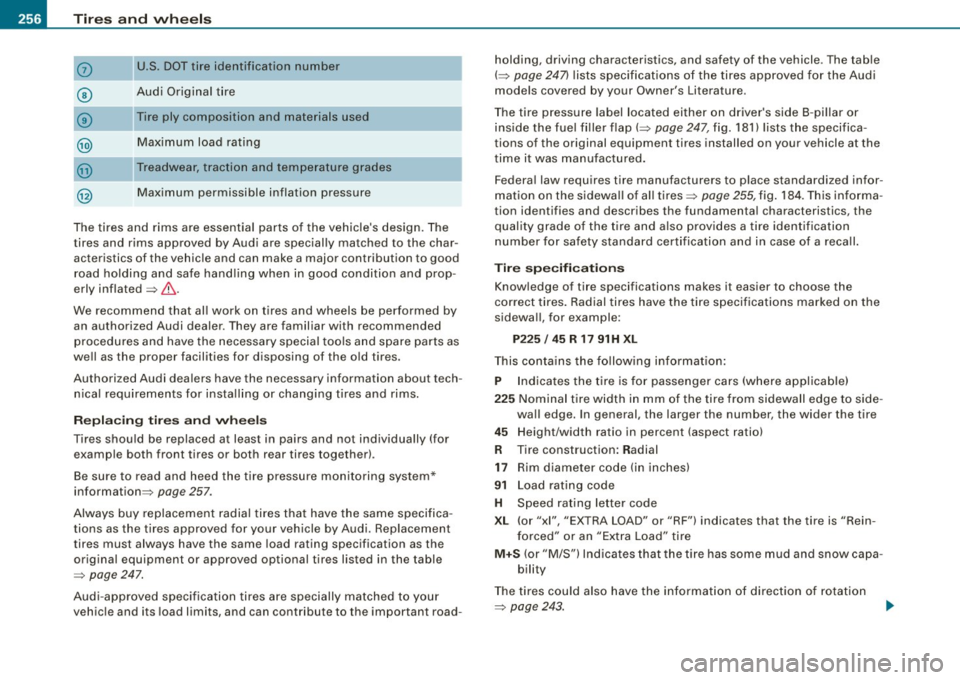
-~_T_ ir_e_ s_ a_ n_d _ w_ h_ e_e _l_s _________________________________________________ _
0
©
G)
@
U.S. DOT tire identification number
Audi Original tire
Tire ply composition and materials used Maximum load rating
Treadwear, traction and temperature grades Maximum permissible inflation pressure
The tires and rims are essential parts of the vehicle's design. The
tires and rims approved by Audi are specially matched to the char acteristics of the vehicle and can make a major contribution to good
road holding and safe handling when in good condition and prop
erly inflated =>& .
We recommend that al l work on tires and wheels be performed by
an authorized Audi dealer . They are familiar with recommended
procedures and have the necessary special tools and spare parts as
we ll as the proper facilities for disposing of the old tires .
Authorized Audi dealers have the necessary information about tech
nical requirements for insta lling or changing tires and rims .
Rep lac ing t ires a nd w heels
Tires should be replaced at least in pairs and not individually (for
example both front tires or both rear tires together) .
Be sure to read and heed the tire pressure monitoring system*
information :::>
page 257.
Always buy replacement radial tires t hat have the same specifica
tions as the tires approved for your vehicle by Audi . Replacement
tires must always have the same load rating specification as the
original equipment or approved optional tires listed in the table
=>
page 247.
Audi -approved specification tires are specially matched to your
vehic le and its load limits, and can contribute to the important road- holding, driving characteristics, and safety of the vehicle
. The table
( =>
page 247) lists specifications of the tires approved for the Audi
models covered by your Owner's Literature.
The tire pressure label located either on driver's side 8 -pi llar or
inside the fuel fi ller flap( =>
page 247, fig. 181 l lists the specifica
tions of the original equipment tires installed on your vehicle at the
time it was manufactured.
Federal law requires tire manufacturers to place standardized infor
mation on the sidewa ll of all tires=>
page 255, fig. 184. This informa
tion identifies and describes the fundamenta l characteristics, the
quality grade of the tire and also provides a tire identification
number for safety standard certification and in case of a recall.
T ire s pec ific ation s
Knowledge of tire specifications makes it easier to choose the
correct tires. Radial tires have the tire specifications marked on the
sidewal l, for example:
P 22 5 / 45 R 17 91H XL
This contains the following information:
P Ind icates the tire is for passenger cars (where applicable)
2 25 Nominal tire width in mm of the tire from sidewall edge to s ide -
wall edge. In general, the larger the number, the wider the tire
45 Height/width ratio in percent (aspect ratio)
R Tire construction: Radial
17 Rim diameter code (in inches)
91 Load rating code
H Speed rating letter code
XL (or "xi", "EXTRA LOAD" or "RF ") indicates that the tire is "Rein
forced" or an "Extra Load" tire
M +S (or "M/S"l Indicates that the tire has some mud and snow capa
bility
The tires cou ld also have the information of direction of rotation
=>
page 243 .
Page 259 of 324
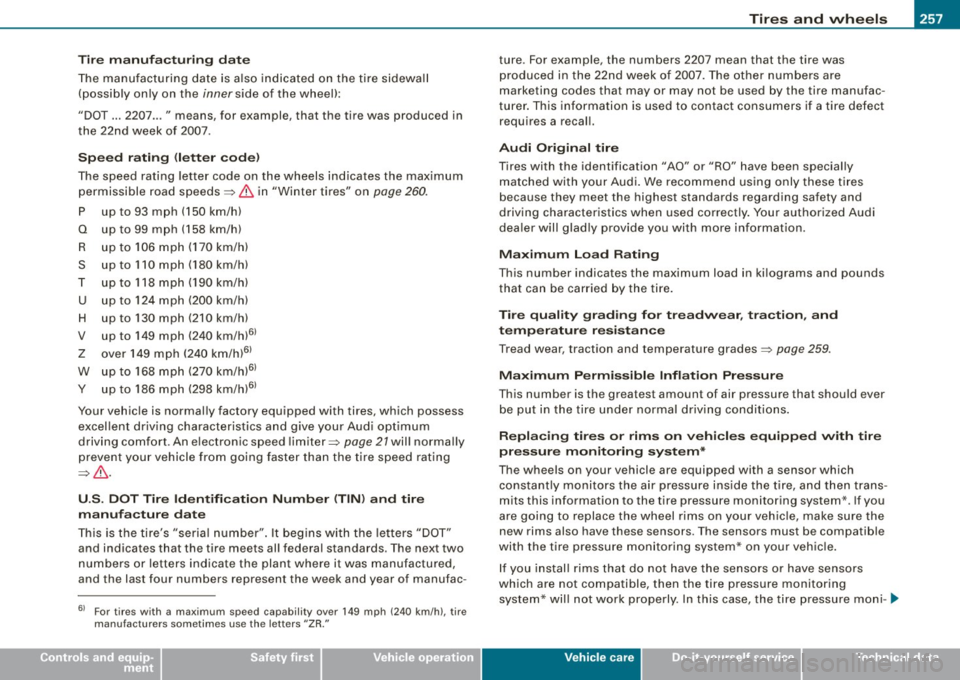
________________________________________________ T_ i _r_e _s_ a_n_ d_ w_ h_ e_e _ l_s __ !II
•
T ire manu fact uring da te
The manufacturing date is a lso indicated on the tire sidewall
(possibly only on the
inner side of the wheell:
"DOT ... 2207 ... " means, for example, that the tire was produced in
the 22nd week of 2007 .
Speed ratin g (let te r cod e)
The speed rating letter code on the wheels indicates the maximum
permissible road speeds=>
& in "Winter tires" on page 260.
P up to 93 mph (150 km/h)
Q up to 99 mph (158 km/h)
R upto106mph(170km/h)
S upto110mph(180km/h)
T upto118mph(190km/h)
U up to 124 mph (200 km/h)
H upto 130mph(210km/h)
V up to 149 mph (240 km/h)6>
Z over 149 mph (240 km/h)6>
W up to 168 mph (270 km/h)6>
Y up to 186 mph (298 km/h)61
Your vehicle is normally factory equipped with tires, which possess
excel lent driving characteris tics and give your Audi optimum
driving comfort. An e lectronic speed limiter=> page
21 will normally
prevent your vehicle from going faster than the tire speed rating
=> & .
U.S . D OT T ire Ident ifi cation Nu mber (TIN ) and tire
m anu fac ture date
This is the tire's "seria l number" . It begins with the letters "DOT"
and indicates that the tire meets all federal standards . The next two
numbers or letters indicate the plant where it was manufactured,
and the last four numbers represent the week and year of manufac-
61 For tires with a maximum speed capability over 149 mph (240 km/h), tire
manufacturers sometimes use the letters "ZR."
ture. For example, the numbers 2207 mean that the tire was
produced in the 22nd week of 2007. The other numbers are
marketing codes that may or may not be used by the tire manufac
turer. This information is used to contact consumers if a tire defect
requires a recall.
Audi Origin al tire
Tires with the identification" AO" or "RO" have been specially
matched with your Audi. We recommend using only these tires
because they meet the highest standards regarding safety and
driving characteristics when used correctly . Your authorized Audi
dea ler will glad ly provide you with more information .
Maximum L oad Rating
This number indicates the maximum load in kilograms and pounds
that can be carried by the tire.
Tir e qu ality gra din g for tr eadw ear, trac tion, a nd
t emper atu re resi stan ce
Tread wear, traction and temperature grades=> page 259.
Max imum P ermi ssibl e Inf latio n Pre ssure
This number is the greatest amount of air pressure that should ever
be put in the tire under normal driv ing conditions .
Repla cing tires or rims on vehicl es equipp ed with tir e
pre ssure monit oring sy stem *
The wheels on your vehicle are equipped with a sensor which
constant ly monitors the air pressure ins ide the t ire, and then trans
mits this information to the tire pressure monitoring system *. If you
are going to replace the wheel rims on your vehic le, make sure the
new rims also have these sensors . The sensors must be compatible
with the tire pressure monitoring system* on your veh ic le.
If you instal l rims that do not have the sensors or have sensors
which are not compatible, then the tire pressure monitoring
system* wil l not work properly. In this case, the tire pressure moni -..
Vehicle care I t •
Page 260 of 324
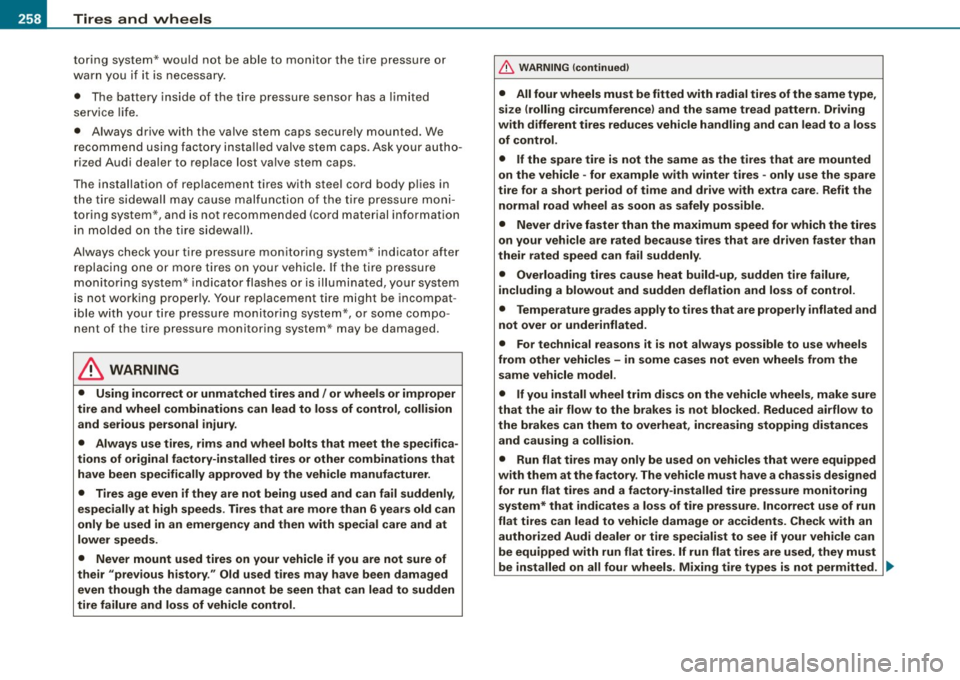
-~_T_ ir_e_ s_ a_ n_d _ w_ h_ e_e _l_s _________________________________________________ _
toring system* would not be able to monitor the tire pressure or
warn yo u if it is n ece ssa ry .
• The battery inside of t he ti re pressure sensor has a l imited
service life.
• Always driv e with the valv e stem caps s ecurely mount ed. We
r ecomme nd u sing fact ory insta lled valve s tem caps . As k your autho
rized Audi d ealer to replace lost va lve stem caps.
T he installation of rep lacement tires with steel cord body p lies in
the t ir e si dewa ll may caus e malf unc tio n of th e tir e pre ssure mo ni
toring system*, and is not recommended (cord material informat ion
in mo lded o n th e tire s idewa ll).
Always check your tire pressu re monitoring system* indicator after
r eplacing one o r more tir e s on yo ur veh icle . If the ti re p ressure
monito ring sy ste m* in dicato r flas hes or is illum inated, you r syste m
is not working p ro perl y. Yo ur replacement ti re might be incompat
i b le with you r tire p ressu re mo nitoring sys tem*, or some compo
nent of the tire pressure monitori ng system* may be damaged.
& WARNING
• Using incorrect or unmatched tires and I or wheels or improper
tire and wheel combinations can lead to loss of control , collision
and serious personal injury .
• Always use tires , rims and wheel bolts that meet the specifica
tions of original factory-installed tires or other combinations that
have been specifically approved by the vehicle manufacturer.
• Tires age even if they are not being used and can fail suddenly,
especially at high speeds . Tires that are more than 6 years old can
only be used in an emergency and then with special care and at
lower speeds .
• Never mount used tires on your vehicle if you are not sure of
their "previous history ." Old used tires may have been damaged
even though the damage cannot be seen that can lead to sudden
tire failure and loss of vehicle control.
& WARNING (continued)
• All four wheels must be fitted with radial tires of the same type,
size (rolling circumference ) and the same tread pattern. Driving
with different tires reduces vehicle handling and can lead to a loss
of control.
• If the spare tire is not the same as the tires that are mounted
on the vehicle - for e xample with winter tires - only use the spare
tire for a short period of time and drive with extra care . Refit the
normal road wheel as soon as safely possible.
• Never drive faster than the maximum speed for which the tires
on your vehicle are rated because tires that are driven faster than
their rated speed can fail suddenly .
• Overloading tires cause heat build-up , sudden tire failure ,
including a blowout and sudden deflation and loss of control .
• Temperature grades apply to tires that are properly inflated and
not over or underinflated .
• For te chnical reasons it is not always possible to use wheels
from other vehicles -in some cases not even wheels from the
same vehicle model.
• If you install wheel trim discs on the vehicle wheels, make sure
that the air flow to the brakes is not blocked. Redu ced airflow to
the brakes can them to overheat , increasing stopping distances
and causing a collision.
• Run flat tires may only be used on vehicles that were equipped
with them at the fa ctory . The vehicle must have a chassis designed
for run flat tires and a factory-installed tire pressure monitoring
system * that indicates a loss of tire pressure . Incorre ct use of run
flat tires can lead to vehicle damage or accidents . Check with an
authorized Audi dealer or t ire specialist to see if your vehicle can
be equipped with run flat tires .
If run flat tires are used, they must
be installed on all four wheels . Mixing tire types is not permitted. .,